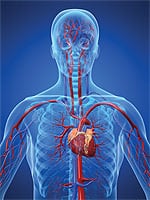Life Extension Magazine®
Hundreds of published studies document the ability of vitamin E to combat cancer, heart disease, obesity, kidney failure, neurodegenerative disorders, and inflammatory responses.1-6 At the same time, we know that conventional vitamin E (alpha-tocopherol) does not by itself confer the omnibus protection that aging people need to remain disease-free. Scientists continue to uncover unique biological properties of a class of vitamin E compounds called tocotrienols. In late 2010, researchers in Singapore released findings from a human study showing that a tocotrienol extract slashed levels of artery-clogging triglycerides by 28%.7 In this article you will learn of the implications this discovery has for individuals with stubbornly high blood lipid levels characteristic of the constellation of pathologies known as metabolic syndrome. Why High Triglycerides Are DangerousTriglycerides accumulate in various organs, where they exert numerous harmful effects, most prominently in cardiac tissue.8 They influence expression of genes related to susceptibility to coronary artery disease.9 Accumulating in the heart, they reduce left ventricular function in a fashion specific to people with metabolic disorders.10 Triglycerides also trigger increased platelet activation, substantially boosting risk of dangerous clot formation. Elevated triglycerides increase incidence of stroke—a risk that can be mitigated by lowering levels of these dangerous fat compounds.11,12 Elevated triglycerides contribute to the three-fold elevation of cardiovascular disease risk seen in those with metabolic syndrome.13,14 People with type 2 diabetes and high liver triglyceride content have poorer blood flow and impaired energy metabolism in their heart tissue.15 The Singapore Study
A report published in 2002 revealed a startling 40% of adults 60 years and older suffered from metabolic syndrome,16 placing them at considerably higher risk for heart attack, stroke, and other age-related diseases. A common characteristic of metabolic syndrome is high blood levels of LDL and triglycerides, along with impaired glucose control, abdominal obesity, and hypertension. Previous reports indicated that tocotrienols could improve the body’s ability to safely lower LDL and triglycerides. A team of Singapore researchers performed a multi-phase study to determine precisely how tocotrienols can exert such favorable effects on blood lipid profiles.7 The Singapore team began with cultured human liver cells, moved on to mice, and finally to human subjects.7 The cell culture studies revealed that tocotrienols (gamma & delta) suppressed gene expression involved in lipid (fat) formation, driving down production of triglycerides and cholesterol. Tocotrienols further enhanced clearance of LDL by up-regulating genes governing LDL’s ability to attach to cells. Animal models revealed that tocotrienol treatment of mice with elevated cholesterol and triglycerides reduced total cholesterol by 25% and triglyceride levels by 19%.7 (Levels of beneficial HDL were not suppressed.) The human portion of the study showed that serum triglyceride levels plummeted by 28% in subjects taking 120 mg per day of gamma-delta-tocotrienol.7 This was accompanied by a reduction of about 13% in very-low density lipoprotein (VLDL), another lipid involved in arterial occlusion. Tocotrienols were also shown to suppress levels of chylomicrons, lipoprotein complexes that transport fats from your intestines to the liver and other parts of your body.7 Tocotrienols, particularly gamma-tocotrienol, have been linked to anti-cancer actions, primarily through their antioxidant and anti-inflammatory effects.
Confirmatory StudiesAn abundance of supportive data reinforces the Singapore team’s findings.
Diabetic rats treated with palm oil-derived tocotrienols had significantly lower levels of total cholesterol, LDL, and triglycerides, and higher HDL levels compared with control animals. Further, the supplemented animals had lower blood sugar and hemoglobin A1c (HbA1c) levels, and microscopic examination of their major blood vessels revealed substantially less disruption than seen in untreated controls.17 Tocotrienols suppress differentiation of pre-adipocytes into mature adipocytes (fat cells), helping to reduce the overall burden of inflammation-generating fat tissue.18 They also reduce synthesis of triglycerides and VLDL particles in the liver, contributing to a reduction in fatty liver in animal studies.7,19 A tocotrienol-rich palm oil preparation has been shown to reduce total cholesterol and LDL levels by as much as 37% in aging individuals with abnormal lipid profiles.20,21 Both tocotrienol-rich palm oil, rice oils, and purified tocotrienols at doses of approximately 100-200 mg per day have induced these beneficial effects.22-24 Diabetics are at especially high risk for these dyslipidemias, and tocotrienol supplements can be particularly helpful in that context. Perhaps because of their especially disrupted lipid profiles, diabetics experience even more powerful lipid-lowering effects from tocotrienol supplementation, including as much as a 42% reduction in LDL.25 As potent antioxidants, tocotrienols have been shown to induce regression of carotid artery narrowing in patients at risk for stroke from atherosclerosis and inhibit LDL oxidation, a precursor to the formation of atherosclerotic lesions.26,27
Quenching the Pro-Inflammatory FireInflammation lies at the core of most chronic age-related diseases. Tocotrienols exert powerful anti-inflammatory effects throughout the body.
They have been shown to attenuate oxidative stress in diabetic tissues, halting a pro-inflammatory cascade that otherwise leads to diabetic neuropathy (nerve pain and damage).28 Tocotrienols favorably modulate the gene-regulating “master switch” nuclear factor-kappaB (NF-kB) to down-regulate expression of cytokines that wreak inflammatory havoc on a host of target tissues.29-31 This mechanism of action protects vulnerable organs such as the kidney from many of the consequences of metabolic syndrome. Still further along the same pro-inflammatory cascade, they prevent intestinal scar-forming cells from proliferating in response to inflammatory bowel disease, helping to reduce the risks of dangerous narrowing of the intestine.32 The anti-inflammatory power of tocotrienols even benefits the skin, which undergoes severe oxidative stress following exposure to UV rays in sunlight.33,34 By suppressing oxidative stress and related NF-kB-related inflammation, tocotrienols prevent the cognitive decline associated with diabetes in laboratory animals.35,36 This effect is powerful enough even to prevent chronic alcohol-induced cognitive losses in rat studies.37 Anti-Cancer MechanismsTocotrienols, particularly gamma-tocotrienol, have been linked to anti-cancer actions, primarily through their antioxidant and anti-inflammatory effects.38,39 In 2010 alone, scientists from prestigious institutions such as the MD Anderson Cancer Center and the National Institute on Aging have contributed to a number of new discoveries about tocotrienols and cancer.
These discoveries reveal the unique actions of tocotrienols on regulatory proteins such as NF-kB, on DNA-repair proteins, and on intracellular signaling systems, all of which contribute to cancer development.40-43 Gamma-tocotrienol, for example, controls expression of cell regulatory and detoxifying proteins in breast cancer cells, suppressing proliferation and preventing progression of nascent cancers.44 Even if a cancer does get started at a microscopic level, tocotrienols can snuff it out by triggering its cells to commit suicide through activation of the aptly named cellular death receptors.45 And in the event of actual tumor development, tocotrienols sensitize cancerous cells to chemotherapy drugs, potentially reducing their required doses and side effects.38,46 Intriguingly, gamma-tocotrienol has been found to target a unique population of cells in prostate tumors.47 These so-called cancer stem cells are unaffected by conventional cancer therapies, thereby accounting for many cases of treatment-resistant cancers and relapses. Tocotrienols also show promise in protecting against the potentially cancer-inducing effects of radiation. While radiation is a cornerstone of modern cancer treatment, it can also increase an individual’s future risk of leukemia and other cancers.48 A pre-clinical study showed that gamma-tocotrienol protected mice against the depletion of blood-forming cells that typically occurs in response to full-body radiation exposure.49 These preliminary findings offer hope that tocotrienols could offer protection against the adverse effects of medical, environmental, and occupational radiation exposures.
SummaryA 2010 study revealed that tocotrienols slash levels of triglycerides by 28% in humans, while supportive research suggests they also mitigate other cofactors implicated in metabolic syndrome. Their multi-targeted anti-inflammatory effects are being recognized as factors in their ability to combat common age-related disorders. If you have any questions on the scientific content of this article, please call a Life Extension® Health Advisor at Editor's NoteScience continues to evolve, and new research is published daily. As such, we have a more recent article on this topic: Fish Oil Drug Advertised on TV | |||||||||
| References | |||||||||
| 1. Ju J, Picinich SC, Yang Z, et al. Cancer-preventive activities of tocopherols and tocotrienols. Carcinogenesis. 2010 Apr;31(4):533-42. 2. Pryor WA. Vitamin E and heart disease: basic science to clinical intervention trials. Free Radic Biol Med. 2000 Jan 1;28(1):141-64. 3. Kuhad A, Chopra K. Attenuation of diabetic nephropathy by tocotrienol: involvement of NFkB signaling pathway. Life Sci. 2009 Feb 27;84(9-10):296-301. 4. Mangialasche F, Kivipelto M, Mecocci P, et al. High plasma levels of vitamin E forms and reduced Alzheimer’s disease risk in advanced age. J Alzheimers Dis. 2010;20(4):1029-37. 5. Calder PC, Albers R, Antoine JM, et al. Inflammatory disease processes and interactions with nutrition. Br J Nutr. 2009 May;101 Suppl 1:S1-45. 6. Okuda M, Bando N, Terao J, et al. Association of serum carotenoids and tocopherols with atopic diseases in Japanese children and adolescents. Pediatr Allergy Immunol. 2010 Jun;21(4 Pt 2):e705-10. 7. Zaiden N, Yap W, Ong S, et al. Gamma delta tocotrienols reduce hepatic triglyceride synthesis and VLDL secretion. J Atheroscler Thromb. 2010 Oct 27;17(10):1019-32. 8. Sarwar N, Sandhu MS, Ricketts SL, et al. Triglyceride-mediated pathways and coronary disease: collaborative analysis of 101 studies. Lancet. 2010 May 8;375(9726):1634-9. 9. Kisfali P, Polgar N, Safrany E, et al. Triglyceride level affecting shared susceptibility genes in metabolic syndrome and coronary artery disease. Curr Med Chem. 2010;17(30):3533-41. 10. de las Fuentes L, Waggoner AD, Brown AL, Davila-Roman VG. Plasma triglyceride level is an independent predictor of altered left ventricular relaxation. J Am Soc Echocardiogr. 2005 Dec;18(12):1285-91. 11. de Man FH, Nieuwland R, van der Laarse A, et al. Activated platelets in patients with severe hypertriglyceridemia: effects of triglyceride-lowering therapy. Atherosclerosis. 2000 Oct;152(2):407-14. 12. Ebinger M, Heuschmann PU, Jungehuelsing GJ, Werner C, Laufs U, Endres M. The Berlin ‘Cream&Sugar’ Study: the prognostic impact of an oral triglyceride tolerance test in patients after acute ischaemic stroke. Int J Stroke. 2010 Apr;5(2):126-30. 13. De Flines J, Scheen AJ. Management of metabolic syndrome and associated cardiovascular risk factors. Acta Gastroenterol Belg. 2010 Apr-Jun;73(2):261-6. 14. Alberti KG, Eckel RH, Grundy SM, et al. Harmonizing metabolic syndrome: a joint interim statement of the International Diabetes Federation Task Force on Epidemiology and Prevention; National Heart, Lung, and Blood Institute; American Heart Association; World Heart Federation; International Atherosclerosis Society; and International Association for the Study of Obesity. Circulation. 2009 Oct 20;120(16):1640-5. 15. Rijzewijk LJ, Jonker JT, van der Meer RW, et al. Effects of hepatic triglyceride content on myocardial metabolism in type 2 diabetes. J Am Coll Cardiol. 2010 Jul 13;56(3):225-33. 16. Ford ES, Giles WH, Dietz WH. Prevalence of metabolic syndrome among US adults: findings from the third National Health and Nutrition Examination Survey. JAMA. 2002 Jan 16;287(3):356-9. 17. Budin SB, Othman F, Louis SR, Bakar MA, Das S, Mohamed J. The effects of palm oil tocotrienol-rich fraction supplementation on biochemical parameters, oxidative stress and the vascular wall of streptozotocin-induced diabetic rats. Clinics (Sao Paulo). 2009;64(3):235-44. 18. Uto-Kondo H, Ohmori R, Kiyose C, et al. Tocotrienol suppresses adipocyte differentiation and Akt phosphorylation in 3T3-L1 preadipocytes. J Nutr. 2009 Jan;139(1):51-7. 19. Yachi R, Igarashi O, Kiyose C. Protective effects of vitamin E analogs against carbon tetrachloride-induced fatty liver in rats. J Clin Biochem Nutr. 2010 Sep;47(2):148-54. 20. Qureshi AA, Qureshi N, Wright JJ, et al. Lowering of serum cholesterol in hypercholesterolemic humans by tocotrienols (palmvitee). Am J Clin Nutr. 1991 Apr;53(4 Suppl):1021S-26S. 21. Tan DT, Khor HT, Low WH, Ali A, Gapor A. Effect of a palm-oil-vitamin E concentrate on the serum and lipoprotein lipids in humans. Am J Clin Nutr. 1991 Apr;53(4 Suppl):1027S-30S. 22. Qureshi AA, Sami SA, Salser WA, Khan FA. Dose-dependent suppression of serum cholesterol by tocotrienol-rich fraction (TRF25) of rice bran in hypercholesterolemic humans. Atherosclerosis. 2002 Mar;161(1):199-207. 23. Qureshi AA, Bradlow BA, Brace L, et al. Response of hypercholesterolemic subjects to administration of tocotrienols. Lipids. 1995 Dec;30(12):1171-7. 24. Ajuluchukwu JN, Okubadejo NU, Mabayoje M, et al. Comparative study of the effect of tocotrienols and -tocopherol on fasting serum lipid profiles in patients with mild hypercholesterolaemia: a preliminary report. Niger Postgrad Med J. 2007 Mar;14(1):30-3. 25. Baliarsingh S, Beg ZH, Ahmad J. The therapeutic impacts of tocotrienols in type 2 diabetic patients with hyperlipidemia. Atherosclerosis. 2005 Oct;182(2):367-74. 26. O’Byrne D, Grundy S, Packer L, et al. Studies of LDL oxidation following alpha-, gamma-, or delta-tocotrienyl acetate supplementation of hypercholesterolemic humans. Free Radic Biol Med. 2000 Nov 1;29(9):834-45. 27. Tomeo AC, Geller M, Watkins TR, Gapor A, Bierenbaum ML. Antioxidant effects of tocotrienols in patients with hyperlipidemia and carotid stenosis. Lipids. 1995 Dec;30(12):1179-83. 28. Kuhad A, Chopra K. Tocotrienol attenuates oxidative-nitrosative stress and inflammatory cascade in experimental model of diabetic neuropathy. Neuropharmacology. 2009 Sep;57(4):456-62. 29. Kuhad A, Chopra K. Attenuation of diabetic nephropathy by tocotrienol: involvement of NFkB signaling pathway. Life Sci. 2009 Feb 27;84(9-10):296-301. 30. Wu SJ, Liu PL, Ng LT. Tocotrienol-rich fraction of palm oil exhibits anti-inflammatory property by suppressing the expression of inflammatory mediators in human monocytic cells. Mol Nutr Food Res. 2008 Aug;52(8):921-9. 31. Yam ML, Abdul Hafid SR, Cheng HM, Nesaretnam K. Tocotrienols suppress proinflammatory markers and cyclooxygenase-2 expression in RAW264.7 macrophages. Lipids. 2009 Sep;44(9):787-97. 32. Luna J, Masamunt MC, Rickmann M, et al. Tocotrienols have potent antifibrogenic effects in human intestinal fibroblasts. Inflamm Bowel Dis. 2011 Mar;17(3):732-41. 33. Nakagawa K, Shibata A, Maruko T, et al. Gamma-tocotrienol reduces squalene hydroperoxide-induced inflammatory responses in HaCaT keratinocytes. Lipids. 2010 Sep;45(9):833-41. 34. Shibata A, Nakagawa K, Kawakami Y, Tsuzuki T, Miyazawa T. Suppression of gamma-tocotrienol on UVB induced inflammation in HaCaT keratinocytes and HR-1 hairless mice via inflammatory mediators multiple signaling. J Agric Food Chem. 2010 Jun 9;58(11):7013-20. 35. Kuhad A, Bishnoi M, Tiwari V, Chopra K. Suppression of NF-kappabeta signaling pathway by tocotrienol can prevent diabetes associated cognitive deficits. Pharmacol Biochem Behav. 2009 Apr;92(2):251-9. 36. Tiwari V, Kuhad A, Bishnoi M, Chopra K. Chronic treatment with tocotrienol, an isoform of vitamin E, prevents intracerebroventricular streptozotocin-induced cognitive impairment and oxidative-nitrosative stress in rats. Pharmacol Biochem Behav. 2009 Aug;93(2):183-9. 37. Tiwari V, Kuhad A, Chopra K. Suppression of neuro-inflammatory signaling cascade by tocotrienol can prevent chronic alcohol-induced cognitive dysfunction in rats. Behav Brain Res. 2009 Nov 5;203(2):296-303. 38. Kannappan R, Yadav VR, Aggarwal BB. {Gamma}-tocotrienol but not {gamma}-tocopherol blocks STAT3 cell signaling pathway through induction of protein-tyrosine phosphatase SHP-1 and sensitizes tumor cells to chemotherapeutic agents. J Biol Chem. 2010 Oct 22;285(43):33520-8. 39. Sylvester PW, Kaddoumi A, Nazzal S, El Sayed KA. The value of tocotrienols in the prevention and treatment of cancer. J Am Coll Nutr. 2010 Jun;29(3 Suppl):324S-33S. 40. Aggarwal BB, Sundaram C, Prasad S, Kannappan R. Tocotrienols, the vitamin E of the 21st century: its potential against cancer and other chronic diseases. Biochem Pharmacol. 2010 Dec 1;80(11):1613-31. 41. Kaileh M, Sen R. Role of NF-kappaB in the anti-inflammatory effects of tocotrienols. J Am Coll Nutr. 2010 Jun;29(3 Suppl):334S-39S. 42. Kunnumakkara AB, Sung B, Ravindran J, et al. {gamma}-tocotrienol inhibits pancreatic tumors and sensitizes them to gemcitabine treatment by modulating the inflammatory microenvironment. Cancer Res. 2010 Nov 1;70(21):8695-705. 43. Chin SF, Hamid NA, Latiff AA,et al. Reduction of DNA damage in older healthy adults by Tri E Tocotrienol supplementation. Nutrition. 2008 Jan;24(1):1-10. 44. Hsieh TC, Elangovan S, Wu JM. gamma-Tocotrienol controls proliferation, modulates expression of cell cycle regulatory proteins and up-regulates quinone reductase NQO2 in MCF-7 breast cancer cells. Anticancer Res. 2010 Jul;30(7):2869-74. 45. Kannappan R, Ravindran J, Prasad S, et al. Gamma-tocotrienol promotes TRAIL-induced apoptosis through reactive oxygen species/extracellular signal-regulated kinase/p53-mediated upregulation of death receptors. Mol Cancer Ther. 2010 Aug;9(8):2196-207. 46. Yap WN, Zaiden N, Luk SY, et al. In vivo evidence of gamma-tocotrienol as a chemosensitizer in the treatment of hormone-refractory prostate cancer. Pharmacology. 2010;85(4):248-58. 47. Luk SU, Yap WN, Chiu YT, et al. Gamma-tocotrienol as an effective agent in targeting prostate cancer stem cell-like population. Int J Cancer. 2010 May 1;128(9):2182-91. 48. O’Donnell MR, Abboud CN, Altman J, et al. Acute myeloid leukemia. J Natl Compr Canc Netw. 2011 Mar;9(3):280-317. 49. Kulkarni S, Ghosh SP, Satyamitra M, et al. Gamma-tocotrienol protects hematopoietic stem and progenitor cells in mice after total-body irradiation. Radiat Res. 2010 Jun;173(6):738-47. 50. Fruchart JC, Sacks F, Hermans MP, et al. The Residual Risk Reduction Initiative: a call to action to reduce residual vascular risk in patients with dyslipidemia. Am J Cardiol. 2008 Nov 17;102(10 Suppl):1K-34K. 51. Whitmer RA, Gustafson DR, Barrett-Connor E, Haan MN, Gunderson EP, Yaffe K. Central obesity and increased risk of dementia more than three decades later. Neurology. 2008 Sep 30;71(14):1057-64. 52. Nicklas BJ, Cesari M, Penninx BW, et al. Abdominal obesity is an independent risk factor for chronic heart failure in older people. J Am Geriatr Soc. 2006 Mar;54(3):413-20. 53. Winter Y, Rohrmann S, Linseisen J, et al. Contribution of obesity and abdominal fat mass to risk of stroke and transient ischemic attacks. Stroke. 2008 Dec;39(12):3145-51. 54. Available at: http://www.americanheart.org/presenter.jhtml?identifier=4778. Accessed March 29, 2011. |





